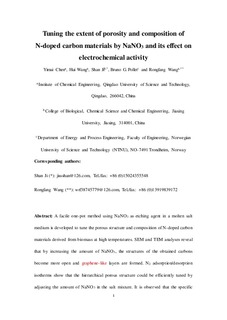| dc.contributor.author | Chen, Y | |
| dc.contributor.author | Wang, H | |
| dc.contributor.author | Ji, Shan | |
| dc.contributor.author | Pollet, Bruno | |
| dc.contributor.author | Wang, Rongfang | |
| dc.date.accessioned | 2019-05-07T13:29:34Z | |
| dc.date.available | 2019-05-07T13:29:34Z | |
| dc.date.created | 2018-09-05T09:15:55Z | |
| dc.date.issued | 2018 | |
| dc.identifier.citation | Materials research bulletin. 2018, 104, 134-142. | nb_NO |
| dc.identifier.issn | 0025-5408 | |
| dc.identifier.uri | http://hdl.handle.net/11250/2596847 | |
| dc.description.abstract | A facile one-pot method using NaNO3 as etching agent in a molten salt medium is developed to tune the porous structure and composition of N-doped carbon materials derived from biomass at high temperatures. SEM and TEM analyses reveal that by increasing the amount of NaNO3, the structures of the obtained carbons become more open and graphene-like layers are formed. N2 adsorption/desorption isotherms show that the hierarchical porous structure could be efficiently tuned by adjusting the amount of NaNO3 in the salt mixture. It is observed that the specific surface area of the as-prepared N-doped carbon using NaNO3 can reach 1430.1 m2 g−1, a much higher value than that of the sample prepared in the absence of NaNO3. The micropore ratio decreases with increased amount of NaNO3, from 49.42% to 9.98%. Whilst the surface composition of the obtained carbon materials is affected by NaNO3. The N content increases and O decreases respectively, by increasing the amount of NaNO3. Analysis on the N 1s high resolution reveals that the sum of pyridinic-N and graphitic-N increased, whereas the sum of pyridinic-N oxide and NOx decreases from NC-0 to NC-0.75. It is also found that the changes of the porous structure and the oxygen-containing groups from NC-0 to NC-0.75 led to changes in hydrophilicity. When the as-prepared carbon materials are used as catalysts for the oxygen reduction reaction, high catalytic activity values are obtained, sample NC-0.5 shows the best performance due to the porous structure and doping effect of N atoms. More importantly, it is concluded that producing N-doped carbon materials from soybean dregs in molten salt medium using NaNO3 as etching agent could provide a promising approach for the synthesis of opened N-doped carbons of controlled porous structures and large specific surface areas based on biomass precursors. | nb_NO |
| dc.language.iso | eng | nb_NO |
| dc.publisher | Elsevier | nb_NO |
| dc.rights | Attribution-NonCommercial-NoDerivatives 4.0 Internasjonal | * |
| dc.rights.uri | http://creativecommons.org/licenses/by-nc-nd/4.0/deed.no | * |
| dc.title | Tuning the extent of porosity and composition of N-doped carbon materials by NaNO3 and its effect on electrochemical activity | nb_NO |
| dc.type | Journal article | nb_NO |
| dc.type | Peer reviewed | nb_NO |
| dc.description.version | acceptedVersion | nb_NO |
| dc.source.pagenumber | 134-142 | nb_NO |
| dc.source.volume | 104 | nb_NO |
| dc.source.journal | Materials research bulletin | nb_NO |
| dc.identifier.doi | 10.1016/j.materresbull.2018.04.012 | |
| dc.identifier.cristin | 1606780 | |
| dc.description.localcode | © 2018 Elsevier Ltd. All rights reserved.This is the authors’ accepted and refereed manuscript to the article, locked until 24 April 2020. This manuscript version is made available under the CC-BY-NC-ND 4.0 license http://creativecommons.org/licenses/by-nc-nd/4.0/ | nb_NO |
| cristin.unitcode | 194,64,25,0 | |
| cristin.unitname | Institutt for energi- og prosessteknikk | |
| cristin.ispublished | true | |
| cristin.fulltext | original | |
| cristin.qualitycode | 1 | |

